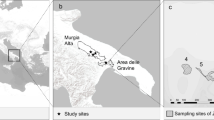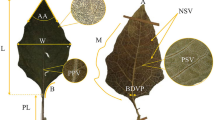Abstract
Evidence is presented which suggests that the spinescence of leaves of European holly, Ilex aquifolium, deters feeding by ungulates and is induced by browsing. Spinescence decreased as leaf size increased; hence, spinescence may be achieved by reducing adult leaf size. Holly shrubs with very spiny leaves were browsed less often than less spiny shrubs. In the absence of browsing ungulates during a one year period, the spinescence of leaves of holly shrubs significantly decreased. Browsed shrubs exhibited reduced annual shoot growth, increased branching, and produced smaller leaves with high spinescence. The regrowth on browsed branches of holly trees was characterized by increased leaf spinescence relative to unbrowsed branches. Hence, the induced response was localized, thereby reducing the ability of browsing ungulates to exert selective pressures on holly trees.
Similar content being viewed by others
References
Abrahamson, W. G. 1975. Reproductive strategies in dewberries. Ecology 56: 721-726.
Bazely, D. R., Myers, J. H. & Burke da Silva, K. 1991. The response of number of bramble prickles to herbivory and depressed resource availability. Oikos 61: 327-336.
Cooper, S. M. & Owen-Smith, N. 1986. Effects of plant spinescence on large mammalian herbivores. Oecologia 68: 446-455.
Cornelissen, J. H. C. 1993. Growth, morphology and leaf characteristics after simulated herbivory in Chinese subtropical evergreen saplings. Ecol. Res. 8: 143-150.
Crawley, M. J. 1983. Herbivory: the dynamics of animal-plant interactions. Blackwell Scientific Publications, Oxford.
Durzan, D. J. 1990. Adult vs. juvenile explants: directed totipotency. Pp. 19-25. In: Rodriguez R., Sánchez R. & Durzan D. J. (eds), Plant aging, basic and applied approaches. Plenum Press, New York.
Ehrlich, P. R. & Raven, P. H. 1967. Butterflies and plants. Sci. Amer. 216: 104-131.
Gibson, D., Bazely, D. R. & Shore, J. S. 1993. Responses of brambles, Rubus vestitus, to herbivory. Oecologia 95: 454-457.
Givnish, T. 1979. On the adaptative significance of leaf form. Pp. 375-407. In: Solbrig O. T., Jain S., Johson G. B. & Raven P. H. (eds), Topics in plant population biology. Columbia University Press, New York.
Grubb, P. J. 1992. A positive distrust in simplicity-lessons from plant defences and from competition among plants and among animals. J. Ecol. 80: 585-610.
Honkanen, T. & Haukioja, E. 1994. Why does a branch suffer more after branch-wide than after tree-wide defoliation? Oikos 71: 441-450.
Karban, R. & Myers, J. H. 1989. Induced plant responses to herbivory. Ann. Rev. Ecol. Syst. 20: 331-348.
Kozlowski, T. T. 1971. Growth and development of trees. Vol. 1. Academic Press, London.
Milewski, A.V., Young, T. P. & Madden, D. 1991. Thorns as induced defenses: experimental evidence. Oecologia 86: 70-75.
Myers, J. H. 1987. Nutrient availability and the deployment ofmechanical defenses in grazed plants: a new experimental approach to the optimal defense theory. Oikos 49: 350-351.
Myers, J. H. & Bazely, D. R. 1991. Thorns, spines, prickles and hairs: are they stimulated by herbivory and do they deter herbivores? Pp. 325-344. In: Tallamy W. & Raupp M. J., (eds), Phytochemical induction by herbivores. John Wiley, New York.
Peterken, G. F. 1966. Mortality of holly (Ilex aquifolium) seedlings in relation to natural regeneration in the New Forest. J. Ecol. 54: 143-150.
Peterken, G. F. & Lloyd, P. S. 1967. Biological flora of the British Isles: Ilex aquifolium L. J. Ecol. 55: 841-858.
Pollard, J. A. 1986. Variation in Cnidoscolus texanus in relation to herbivory. Oecologia 70: 411-413.
Pollard, J. A. 1992. The importance of deterrence: responses of grazing animals to plant variation. Pp. 216-239. In: Fritz R. S. & Simms E. L. (eds), Plant resistance to herbivores and pathogens: Ecology, evolution, and genetics. Chicago University Press, Chicago.
Potter, D. A. & Kimmerer, T.W. 1986. Seasonal allocation of defense investment in Ilex opaca Aiton and constraints on a specialist leafminer. Oecologia 69: 217-224.
Potter, D. A. & Kimmerer, T. W. 1988. Do holly leaf spines really deter herbivory? Oecologia 75: 216-221.
Pullin, A. S. & Gilbert, J. E. 1989. The stinging nettle, Urtica dioica, increases trichome density after herbivore andmechanical damage. Oikos 54: 275-280.
Seif el Din, A. & Obeid, M. 1971. Ecological studies of the vegetation of the Sudan. IV. The effects of simulated grazing on the growth of Acacia senegal (L.) Willd. seedlings. J. Appl. Ecol. 8: 211-216.
Supnick, M. 1983. On the function of leaf spines in Ilex opaca. B. Torrey Bot. Club 110: 228-230.
Trippi, V. S. 1963. Studies on ontogeny and senility in plants. 1. Changes of growth vigor during the juvenile and adult phases of ontogeny in Tilia parviflora, and growth in juvenile and adult zones of Tilia, Ilex aquifolium and Robinia pseudoacacia. Phyton 20: 137-145.
Trippi, V. S. 1990. Aging of meristems and morphogenetic potentialities. Pp. 3-10. In: Rodriguez R., Sánchez R. & Durzan D. J. (eds), Plant aging, basic and applied approaches. Plenum Press, New York.
Underwood, A. J. 1981. Techniques of analysis of variance in experimental marine biology and ecology. Ocean. Mar. Biol. Ann. Rev. 19: 513-605.
White, P. S. 1988. Prickle distribution in Aralia spinosa (Araliaceae). Am. J. Bot. 75: 282-285.
Young, T. P. 1987. Increased thorn length in Acacia depranolobium: an induced response to browsing. Oecologia 71: 436-438.
Author information
Authors and Affiliations
Rights and permissions
About this article
Cite this article
Obeso, J.R. The induction of spinescence in European holly leaves by browsing ungulates. Plant Ecology 129, 149–156 (1997). https://doi.org/10.1023/A:1009767931817
Issue Date:
DOI: https://doi.org/10.1023/A:1009767931817




